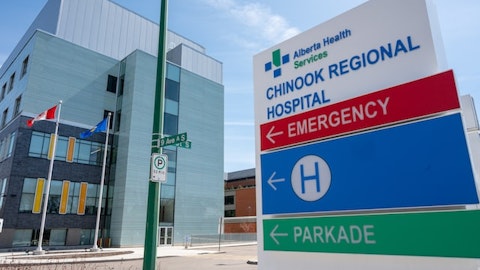Community Healthcare Trust Incorporated (NYSE:CHCT) Q3 2023 Earnings Call Transcript November 1, 2023
Operator: Welcome to Community Healthcare Trust’s 2023 Third Quarter Earnings Release Conference Call. On the call today, the company will discuss its 2023 third quarter financial results. It will also discuss progress made in various aspects of its business. [Operator Instructions]. The company’s earnings release was distributed last evening and has also been posted on its website at www.chct.reit. The company wants to emphasize that some of the information that may be discussed on this call will be based on information as of today, November 1, 2023, and may contain forward-looking statements that involve risk and uncertainty. Actual results may differ materially from those set forth in such statements. For a discussion of the risks and uncertainties, you should review the company’s disclosures regarding forward-looking statements in its earnings release as well as its risk factors and MD&A in its SEC filings.
The company undertakes no obligation to update forward-looking statements, whether as the result of new information, future developments or otherwise, except as may be required by law. During this call, the company will discuss GAAP and non-GAAP financial measures. A reconciliation between the 2 is available in its earnings release, which is posted on its website. Call participants are advised that this conference call is being recorded for playback purposes. An archive of the call will be made available on the company’s Investor Relations website for approximately 30 days and is the property of the company. This call may not be recorded or otherwise reproduced or distributed without the company’s prior written permission. Now I would like to turn the call over to Dave Dupuy, CEO of Community Healthcare Trust.
David Dupuy: Thank you. Good morning, and thank you for joining us today for our 2023 third quarter conference call. On the call with me today is Bill Monroe, our Chief Financial Officer; Leigh Ann Stach, our Chief Accounting Officer; and Tim Meyer, our EVP of Asset Management. Our earnings announcement and supplemental data report were released last night and furnished on 8-K, and our quarterly report on 10-Q was filed last night. In addition, an updated investor presentation was posted to our website last night. The third quarter was busy, both from an operations — both, I’m sorry, from an acquisition standpoint and also from an operations standpoint. During the quarter, we acquired 7 properties with a total of approximately 177,000 square feet for a purchase price of approximately $51.7 million.
The properties were 99.8% leased, with leases running through 2038, and anticipated annual returns of approximately 9.1% to 10.37%. Subsequent to September 30, we acquired 2 medical office buildings in a single transaction for a purchase price of $7.1 million. The properties were 96.8% leased, with leases running through 2031. From an operations perspective, our weighted average remaining lease term remained stable at 7.1 years. Occupancy decreased from 91.7% to 91%. That decrease can be attributed to GenesisCare lease rejection occurring in the quarter. As it relates to GenesisCare, we had 1 lease rejection during the quarter at 46,000 square feet, square foot building in Fort Myers, Florida, in which GenesisCare was the sole tenant. When coupled with the lease in Asheville rejected in the prior quarter, the 2 leases have been rejected representing 57,000 square feet and have seen good leasing activity at both locations.
As of September 30, 2023, GenesisCare was the sole tenant in 5 of our properties and a tenant in 2 of our multi-tenanted properties, representing approximately 1.9% of our gross real estate properties, or approximately 62,000 square feet. Based on recent court filings, the GenesisCare bankruptcy timeline has been extended with the auction currently scheduled for today, November 1. We and our outside counsel continue to monitor the situation closely, and our asset management team is prepared to engage quickly as the bankruptcy process progresses. As it relates to our pipeline, the company has 7 properties to be acquired after completion and occupancy for an aggregate expected investment of $166.5 million. The expected return on these investments should range from 9.1% to 9.75%.
We currently expect to close on these properties throughout 2024 and 2025. We continue to have many properties under review and have term sheets out on several properties with indicative returns of 9% to 10%-plus. We anticipate having enough availability on our credit facilities and through our banking relationships to fund our acquisitions, and we expect to continue to opportunistically utilize the ATM to strategically access the equity markets. To wrap up, we declared our dividend for the third quarter and raised it to $0.455 per common share. This equates to an annualized dividend of $1.82 per share. We are proud to have raised our dividend every quarter since our IPO. That takes care of the items I wanted to cover. So I will hand things off to Bill to discuss the numbers.
William Monroe: Thank you, Dave. I will now provide more details on our third quarter financial performance. I’m pleased to report that total revenue grew from $24.8 million in the third quarter of 2022 to $28.7 million in the third quarter of 2023, representing 15.8% annual growth over the same period last year. When compared to our $27.8 million of total revenue in the second quarter of 2023, we achieved 3.3% total revenue growth quarter-over-quarter. And on a pro forma basis, if the acquisitions we completed during the third quarter of 2023 had occurred on the first day of the third quarter, our total revenue would have increased by an additional $757,000 to a pro forma total of $29.5 million in the third quarter. From an expense perspective, property operating expenses increased by approximately $670,000 quarter-over-quarter to $5.5 million, primarily as a result of properties acquired during the period, but also due to seasonal increases in HVAC repairs and utilities expense caused by the hot summer months.
General and administrative expenses decreased from $3.8 million in the second quarter of 2023 to $3.6 million in the third quarter of 2023. This decrease was driven by the onetime increase in employer Medicare taxes paid in the second quarter from the vesting of our former CEO and President’s shares. Interest expense increased from $4.1 million in the second quarter of 2023 to $4.6 million in the third quarter of 2023 due to the increase in borrowings under our revolving credit facility to fund acquisitions as well as slightly higher interest rates under our revolving credit facility during the quarter. Moving to funds from operations. FFO increased from $13.8 million in the third quarter of 2022 to $15 million in the third quarter of 2023, or 8.9% growth year-over-year.
FFO decreased from $15.9 million in the second quarter of 2023 to $15 million in the third quarter of 2023, and on a per diluted common share basis over these periods, FFO declined from $0.62 to $0.58 per share. But it is important to remember, our second quarter 2023 FFO included a $700,000 or $0.03 per share net casualty gain from insurance proceeds received related to 1 property that was vandalized. Adjusted funds from operations, or AFFO, which adjusts for straight-line rent and stock-based compensation, totaled $16.4 million in the third quarter of 2023, which compares to $15.4 million in the third quarter of 2022, or 6.9% growth year-over-year. On a per diluted common share basis, AFFO was $0.63 in the third quarter of 2022 and also $0.63 in the third quarter of 2023.
AFFO for the second quarter of 2023 was $16 million. So our AFFO grew by 2.4% quarter-over-quarter. And finally, on a pro forma basis, if the acquisitions we completed during the third quarter of 2023 had occurred on the first day of the third quarter, AFFO would have increased by approximately $443,000 to a pro forma total of $16.9 million or $0.65 per diluted common share. That concludes our prepared remarks. Joe, we are now ready to begin the question-and-answer session.
Operator: [Operator Instructions]. At this time we will take our first question, which will come from Connor Mitchell with Piper Sandler.
Connor Mitchell: So you guys have done a great job of finding your compensation with all stock. But just thinking about as you hire new talent for the company going forward, can you provide any updated thoughts on how the mix of cash versus stock compensation would look? And then how might that impact G&A given the all stock was, I believe, a 2x multiplier versus cash without the multiplier?
See also Billionaire Paul Singer’s Top 10 Holdings and Recent Moves and 13 Best 3D Printing Stocks To Invest In.
Q&A Session
Follow Community Healthcare Trust Inc (NYSE:CHCT)
Follow Community Healthcare Trust Inc (NYSE:CHCT)
David Dupuy: Connor, thanks for the question. I hope all is well. So as it relates to cash versus stock mix, we are in the process now of working with the — as everyone may recall, ISS provided a — unfortunately, a vote against say-on-pay despite our strong alignment with shareholders that we believe. And — but as part of that, we knew that we were going to work with the Compensation Committee and the Board to look at — along with our compensation consultant to look at the need of compensation. And that process is ongoing. So I can’t give you any guidance on that yet, Connor. I think it’s safe to say that there will be some mix of cash and stock going forward. But again, we’re in the early stages of evaluating how that’s going to work and what that’s going to look like. And we’re just, at this point, not prepared to disclose any details on that. And my guess is, at some point in the next, I don’t know, 6 months or so, that will be disclosed.
Connor Mitchell: Yes, of course, of course. And then maybe looking at a different topic. The build-to-suit opportunity, given what’s going on in construction lending and banks pulling back, do you see maybe some weakening from the core group of developers and the merchant and entrepreneurial developers? And then along with that, would you guys be comfortable stepping in to maybe fund some developments? Or would you rather let the developments take place and then acquire once it is leased up and stabilized?
David Dupuy: So what I would say is, we have a core group of banks that we’ve worked with for years that actually like to go in, fund these development projects with our takeout upon certificate of occupancy. And even though there’s some level of pressure we’ve seen broadly within the banking community, those types of deals continue to work for the banks that have done business with us in the past. As far as your second question, would we be open to doing some of those development projects or funding some of those development projects ourselves, we would certainly take a look. I think our preferred vehicle is have our bank partners fund those projects, and then have us take those projects out. There’s no question just given the overall cost of debt those projects have become a little bit more expensive for our development partners.
And I think they’re working with their lenders and, frankly, their construction budgets to make sure that they can develop projects more quickly and more efficiently to help counteract the increase in debt. But with the folks that we’re working with now, we haven’t seen a significant change. Obviously, we’re looking at that very closely. And if things evolve or change, we can adapt as well. But our preferred method is to work with our partner banks, and that’s kind of what we intend to do going forward.
Operator: And our next question will come from Rob Stevenson with Janney.
Robert Stevenson: Dave, where was the coverage on the 2 rejected GenesisCare assets versus the remaining assets? Just trying to get a feel for if there was a major difference between the profitability of those 2 centers and the others?
David Dupuy: Yes. So it’s actually — that gives me an opportunity to take a step back and sort of describe those 2 facilities. So Asheville, I think we mentioned on our last call, the first lease rejection, that lease was actually we were working through a termination with the tenant there because they had decided not to continue to provide services at that location. So we were not at all surprised that, that lease was going to get rejected as part of this process. Obviously, we were disappointed that our termination was not resolved, and our settlement was not resolved before that. So that is the Asheville situation. So they were not providing care in that facility at the time. The other location in Fort Myers is essentially an office use, a back-office space, administrative space that GenesisCare was using.
And so, again, disappointed that, that lease was rejected, but not all together surprising given the dynamics. The remaining leases that we have in place are all for clinics, health care providers that are providing cancer care to patients. And so we think those are obviously more stable than the other ones. We do not get financial statements on a center-by-center basis to answer your question from a coverage standpoint, so can’t give you coverage levels here.





